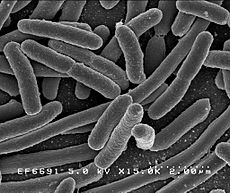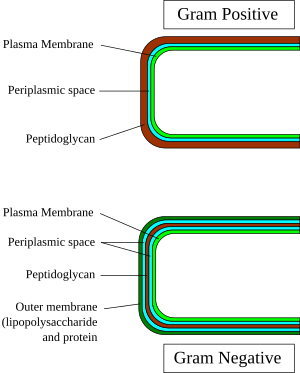Proteobacteria facts for kids
Quick facts for kids Proteobacteria |
|
|---|---|
 |
|
| Escherichia coli | |
| Scientific classification | |
| Domain: | |
| Phylum: |
Proteobacteria
Stackebrandt et al., 1988
|

The Proteobacteria are a very large group, or phylum, of tiny living things called bacteria. You can find them almost everywhere on Earth!
These bacteria are known as gram-negative bacteria. This means they do not hold onto a special purple dye used in a test called the Gram stain. This test helps scientists tell different types of bacteria apart by looking at their cell walls.
In the Gram stain test, after the purple dye, another pink dye is added. This second dye makes all gram-negative bacteria look pink or red. This simple test is very useful for classifying bacteria based on how their cell walls are built.
Some Proteobacteria can be pathogens, which means they can make people or animals sick. Famous examples include Escherichia coli (often called E. coli), Salmonella, Vibrio, and Helicobacter. However, many other Proteobacteria are very helpful! For example, some help plants get important nutrients from the soil in a process called nitrogen fixation.
Most Proteobacteria can live without oxygen, or they can live with or without it. They get their energy from chemicals, or they get it by eating other things. There are many different kinds, so there are always exceptions!
You can also find Alphaproteobacteria, a type of Proteobacteria, floating in the ocean. They are a big part of the tiny living things in the open ocean.
Contents
What Are Proteobacteria?
Proteobacteria are a major group of bacteria. They are all gram-negative, meaning they have a specific type of cell wall. This wall does not hold the purple dye used in a test called the Gram stain. Instead, they turn pink or red in this test.
This group includes many different kinds of bacteria. Some can cause diseases, while others are very important for the environment. For example, some help plants grow by changing nitrogen gas into a form plants can use.
Gram Stain: How Bacteria Are Identified
The Gram stain is a common test used by scientists to identify bacteria. It helps them see differences in the bacteria's cell walls.
Here's how it works:
- First, a purple dye is added to the bacteria.
- Then, a special solution is added that helps the dye stick.
- Next, alcohol is used. Gram-positive bacteria keep the purple dye, but gram-negative bacteria (like Proteobacteria) lose it.
- Finally, a pink or red dye is added. Since gram-negative bacteria lost the purple dye, they now pick up the pink dye and turn pink or red.
This test is quick and helps scientists know if they are dealing with gram-positive or gram-negative bacteria. This information is important for understanding how to treat infections.
Where Do Proteobacteria Live?
Proteobacteria live in many different places. You can find them in:
- Soil: Many helpful Proteobacteria live in the soil. They play a big role in keeping the soil healthy.
- Water: They are common in freshwater and saltwater. Some types, like Alphaproteobacteria, are a large part of the tiny life in the ocean.
- Inside Living Things: Some Proteobacteria live inside plants, animals, and humans. While some can cause sickness, many others live peacefully with us and even help us. For example, some E. coli live in our intestines and help with digestion.
- Extreme Environments: Some Proteobacteria can even live in places with very little oxygen or unusual chemical conditions.
Types of Proteobacteria
Scientists divide Proteobacteria into several main groups, or "subdivisions," based on their genetic makeup. Each group has different kinds of bacteria with unique roles.
- Alphaproteobacteria: These include bacteria found in the ocean, and some that help plants fix nitrogen. Examples are Agrobacterium and Rickettsia.
- Betaproteobacteria: This group includes bacteria found in soil and water. Some can help clean up pollution.
- Gammaproteobacteria: This is a very diverse group. It includes many well-known bacteria like Escherichia coli, Salmonella, and Pseudomonas. Some of these can cause diseases, while others are important in the environment.
- Deltaproteobacteria: These bacteria are often involved in breaking down sulfur and other chemicals in the environment. They include Myxobacteria, which are known for their unique way of moving and forming groups.
See also
 In Spanish: Proteobacteria para niños
In Spanish: Proteobacteria para niños


